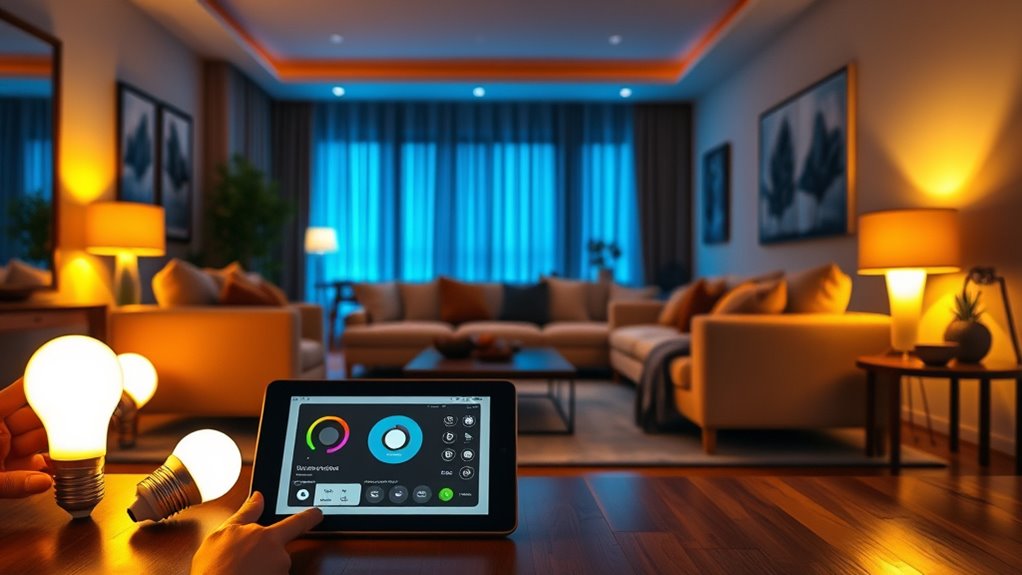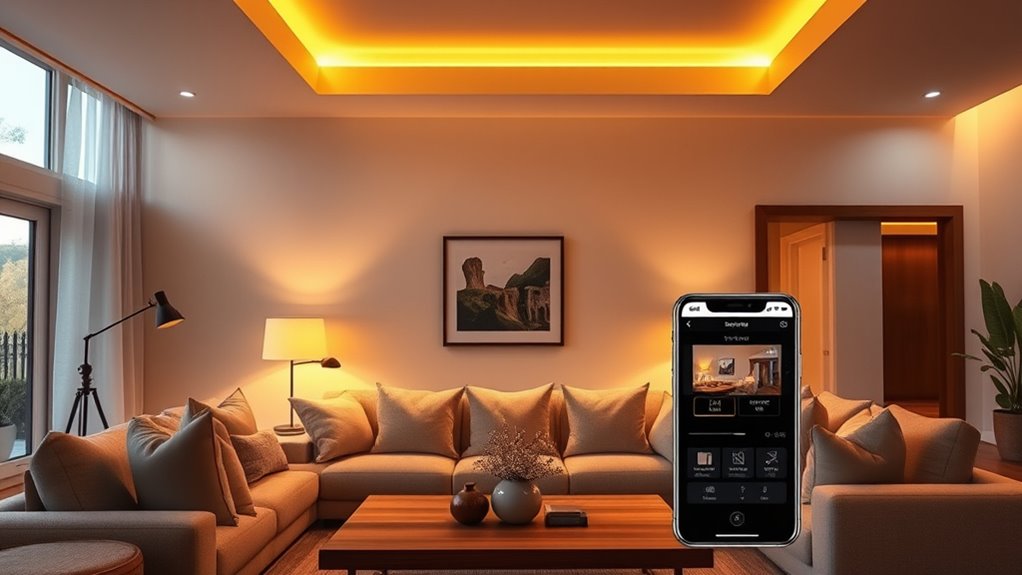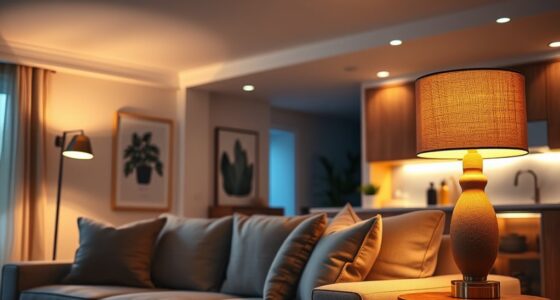Smart lighting lets you easily set the mood and save energy by controlling lights remotely through your phone or voice commands. You can adjust brightness, change colors, or create scene presets for different occasions like movie nights or relaxing evenings. Using energy-efficient bulbs and scheduling, you reduce power consumption and extend bulb life. With these features, your home becomes more comfortable and eco-friendly. Keep exploring to discover how to optimize your lighting for every moment.
Key Takeaways
- Use smart controls to easily change colors and brightness, creating personalized atmospheres for different occasions.
- Schedule lights to turn off automatically when not needed, reducing energy consumption and costs.
- Choose energy-efficient LED bulbs with longer lifespans to save on replacements and lower electricity bills.
- Integrate voice commands for quick mood adjustments without physical switches or remote controls.
- Set automatic scenes for activities like movie nights or relaxation to optimize lighting and enhance ambiance.

Have you ever wondered how smart lighting can transform your home? It’s not just about making your space look good; it’s about creating an environment that’s both stylish and functional. One of the biggest advantages is the ability to control your lights remotely. With remote control lighting, you can turn lights on and off, dim them, or change their color from anywhere—whether you’re relaxing on the couch, in bed, or halfway across the world. This convenience means you never have to get up just to flip a switch, saving time and effort. Plus, it adds a layer of security, as you can make it look like someone’s home even when you’re away.
When it comes to energy efficiency, smart lighting really shines. By using energy-efficient bulbs, you considerably reduce your electricity bill and your home’s carbon footprint. These bulbs consume less power compared to traditional incandescent bulbs, often last much longer, and produce less heat. Paired with smart controls, they allow you to fine-tune your lighting to match your needs. For instance, you can set schedules so your lights turn off automatically when you’re not around or adjust brightness to avoid unnecessary energy consumption. This means you’re not wasting electricity on lights that don’t need to be on, which is better for your wallet and the environment.
Setting the mood with smart lighting is effortless. With a few taps on your smartphone or voice commands, you can change the color and intensity of your lights to suit any occasion. Want a cozy, warm glow for movie night? Or bright, cool light for doing chores? Smart lighting makes it easy. You can even set different scenes that activate automatically—like dimming the lights and changing their hue when you start a romantic dinner or turn on bright white light for a focused work session. Additionally, understanding the contrast ratio of your lighting setup can help you create more visually appealing environments, especially in home theaters or entertainment areas. This flexibility transforms your home into a dynamic space that adapts to your lifestyle, making every moment more enjoyable.
Frequently Asked Questions
Can Smart Lighting Be Integrated With Existing Home Automation Systems?
Yes, you can definitely integrate smart lighting with your existing home automation systems. This allows you to use voice control for easy operation and enjoy numerous customization options to suit your preferences. Most smart lights are compatible with popular platforms like Alexa, Google Assistant, or Apple HomeKit, making setup simple. Once integrated, you can effortlessly control your lighting, set schedules, and create the perfect ambiance with just a few commands.
What Are the Initial Costs and Long-Term Savings of Smart Lighting?
When comparing the initial costs and long-term savings of smart lighting, you’ll find a favorable cost comparison over time. Smart bulbs tend to be more expensive upfront, but they offer significant energy savings by reducing electricity use. These savings can offset the initial investment within months or a few years, making smart lighting a smart choice for lowering your energy bills and enhancing convenience.
How Secure Are Smart Lighting Systems From Hacking or Unauthorized Access?
Imagine your smart lighting system gets hacked, exposing your privacy. Cybersecurity risks and privacy concerns are real, but you can mitigate them. Use strong passwords, keep firmware updated, and choose reputable brands with robust security measures. While no system is completely immune, these steps help protect you from unauthorized access. Regularly reviewing your device’s security settings ensures your smart lighting remains safe and secure.
Are Smart Lights Suitable for Outdoor or Weather-Exposed Environments?
You might wonder if smart lights suit outdoor or weather-exposed areas. Durability concerns are valid, but many smart lights now include weatherproof features designed to withstand rain, snow, and humidity. When choosing outdoor smart lighting, look for products with an appropriate IP (Ingress Protection) rating, as these indicate their ability to handle harsh weather. This guarantees your smart lighting remains reliable and functional regardless of the elements.
How Do Smart Lighting Controls Impact Overall Home Energy Consumption?
Think of smart lighting controls as a conductor guiding an orchestra—you optimize energy use effortlessly. When you use energy-efficient bulbs and occupancy sensors, you cut waste by ensuring lights turn off when rooms are empty. This can reduce your home’s energy consumption markedly, sometimes by up to 30%. These controls help you save money and energy, making your home smarter and more sustainable without sacrificing comfort.
Conclusion
So, here’s the irony: all this smart lighting tech is designed to make your life easier and more energy-efficient, yet we often forget to actually use it. Instead of flipping switches, you could be relaxing with your favorite dimmed glow, saving energy without even thinking about it. Who knew that the future of lighting would turn you into a lazy genius? Embrace your smart lights—you might just find it’s the easiest upgrade you’ve ever made.









